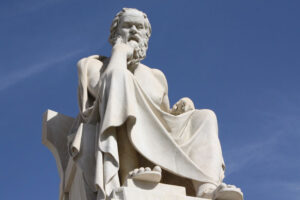

A liberal arts degree is about freedom. That freedom comes from both the spirit of academic enquiry that goes toward your intellectual interests and the flexibility to take your life and career in any direction. For many, that all starts in their undergraduate years with a liberal arts major. Springing from some of the most cherished and oldest ideas about freedom of thought and responsibility that built the society we live in today, a liberal arts education still has a lot to offer, both in terms of enrichment and career preparation.
View Liberal Arts Undergraduate and Graduate Degrees
Our modern ideas of who is worthy to be free are a lot more liberal than those of the Greeks and Romans. But the ideal that a democracy demands well-rounded, thoughtful citizens has stayed amazingly similar. An active participant in civil society today still needs the ability to participate in public debate, to serve on a jury, to understand laws and legal proceedings, to communicate with their peers.
When liberal ideas of equality, rights, and responsibilities became widespread in Western societies, the obligation of that society to offer the education to meet those responsibilities became the public school systems we have today. They teach the sort of broad, general knowledge you need to be strong participant and contributor to society, and do it by encouraging individual thought, reasoning, and discussion.
Earning a dedicated liberal arts degree puts you in line with a long tradition of thinkers and innovators.
The Liberal Arts Degree Has Shaped Western Civilization
The fact that a liberal arts degree was the predominant form of education for hundreds of years in the Western world means that most of the historical figures you admire were probably liberal arts majors. Before Joshua Lawrence Chamberlain held Little Round Top for a Union victory at Gettysburg, he graduated in liberal arts from Bowdoin. Despite struggling in Latin and Greek, Teddy Roosevelt graduated magna cum laude from Harvard with a Bachelor of Arts—and put an indelible stamp on American history in politics, environmentalism, and global affairs.
Liberal arts majors make history.
A liberal studies major graduates with the tools they need to make an impact on the world. And the philosophy, morality, and ethics concepts they study along the way helps them use those tools wisely.
A Liberal Arts Education is About How You Learn, Not Just What You Learn
Liberal arts education isn’t just about the title of the degree. In large part, it represents an idea about the best ways to both teach and learn. It’s such a widespread and widely-accepted concept that you’re probably already more familiar with it than you might realize.
The idea of liberal arts teaching as we experience it today predates the universities that offer liberal arts degrees by thousands of years, going all the way back to ancient Greece.
Socrates, the same guy that said “The unexamined life is not worth living,” made a name for himself standing around and examining life with students all day.
This wasn’t all that different from any other random philosopher in a robe, but Socrates had a kind of system in his teaching. Rather than standing up in front of a crowd delivering lectures all day, Socrates would put himself in the middle of a group of his students and simply discuss things with them. And rather than giving them all the answers, most of his part of the conversations consisted of asking questions… questions designed to make the student think, to evaluate the subject at hand, to examine their own thoughts and understanding.
This, the so-called Socratic Method, has become the basis for most American education, not just for liberal studies majors. The idea that debate and discussion can uncover knowledge and stimulate critical thinking is such a foregone conclusion in schools today that it’s entirely possible that no one ever told you that you were engaged in a fundamental aspect of liberal arts education.
 The modern university system, and the very system of degrees, came pretty firmly out of the liberal arts tradition. The medieval universities that came up with the degree system in the first place were entirely dedicated to teaching the liberal arts—the only real course of curriculum that existed at the time, apart from theological studies.
The modern university system, and the very system of degrees, came pretty firmly out of the liberal arts tradition. The medieval universities that came up with the degree system in the first place were entirely dedicated to teaching the liberal arts—the only real course of curriculum that existed at the time, apart from theological studies.
The rediscovery of the writings of Aristotle in the 12th century fired up thinkers in Western Europe. The Renaissance was underway, sparking new art, new science, and new technology. The ideas of ancient philosophers was heady new stuff, and scholars wanted to get together to talk about it.
Universities already existed by this time, primarily educating clergy and teachers themselves. But the incorporation of Greek philosophies stressed learning through dialectical reasoning, or debate. Previously, rote learning and lecture dominated education. But by the early modern period, almost all secular universities had developed collaborative investigation and the exchange of ideas as their educational model. That created exactly the base of research and study that you recognize as a university today.
What Makes a Liberal Arts Major Different From Other Degree Programs?
If most college degrees today follow a liberal arts pattern, then what is it about liberal studies majors that make them different?
Liberal arts majors today have a wide latitude in both what and how they study. A liberal studies major might have a focus or concentration in areas like arts and humanities or natural science and mathematics, but no set curriculum that they are required to complete. Instead, they may build out their own ideal course of study with the guidance of counselors and faculty advisors.
Liberal arts degrees are designed for students who are mature enough to participate in guiding their own education.
Earning a liberal arts degree means being self-motivated. A liberal arts education builds you into a more self-assured, more capable, more competent graduate than a degree that was tightly scripted in a specific field.
Online Liberal Arts Degrees Are Offering New Options for Liberal Studies Majors
 Because a liberal arts education is aimed at a more mature set of students, it only makes sense that online liberal arts degrees are becoming more and more common. Mature students might be slightly older, and maybe already out in the workforce. The kind of flexibility needed by those students to fit their studies in around personal and professional obligations is exactly what an online liberal arts degree can offer.
Because a liberal arts education is aimed at a more mature set of students, it only makes sense that online liberal arts degrees are becoming more and more common. Mature students might be slightly older, and maybe already out in the workforce. The kind of flexibility needed by those students to fit their studies in around personal and professional obligations is exactly what an online liberal arts degree can offer.
A liberal arts education revolves around interaction with professors and other students.
At first glance, you might think this kind of interpersonal contact suffers in online programs. But in fact, going online only opens up the ways you can engage with professors and peers. Internet-based communication isn’t limited to class time; you can fire off an email with your thoughts any time of the day or night, or drop in on a chat channel in the wee hours of the morning to see who else is up and jazzed about your latest reading assignment.
Location-independent studies also increase the diversity of the people you find yourself interacting with. You’ll get more opinions, broader perspectives, and more interesting ideas from fellow students scattered across the country, or even from around the world.
The Curriculum in a Liberal Arts Degree Covers Both Modern Developments and Classic Thought
Liberal arts has grown far beyond the basic subjects that the ancients came up with. Pythagoras wouldn’t recognize the course of study at a modern liberal arts college (although he was a bright guy and could have figured it out after you taught him some English).
So what does the modern equivalent of a liberal arts curriculum look like? It probably won’t surprise you that different colleges come at it from different directions. In fact, it should thrill you! The free and fair competition of ideas is essential to liberal arts.
One thing you can always say about a liberal arts education is that it’s going to be well-rounded. Coursework is eclectic, drawing on all the core subject areas in the arts and sciences. So you can expect classes in areas such as:
Writing and Literature
Communications are a key part of every liberal studies curriculum. You’ll learn by example here by studying literature from a wide variety of sources, seeing how other authors get their concepts and ideas across. You’ll also be expected to demonstrate proficiency in your own written communications in a variety of subject areas.
History and Society
Not only is it a great idea to learn the patterns of history to avoid mistakes that your predecessors have made, but understanding the world around you includes learning how it got that way. That makes history a key component of liberal arts curriculums. You will look at both global and national historical events as well as more general pictures of what the overall human experience might have been at different points in the past. You’ll draw lessons from those events as well as draw lines between them and the way that society is structured and operates today.
Foreign Languages
Early liberal arts studies all happened in Latin, so learning a foreign language was a necessity for studying in the first place. Lucky you, you get to learn all these classes in your own native tongue now… but most liberal arts curriculums still include some foreign language study requirements.
Philosophy and Logic
Expect classes in thinking about how to think. Liberal arts programs deconstruct themselves through coursework in philosophy and reasoning. At the same time you are going through a program designed to deepen your critical thinking skills, you will be expected to think critically about it. These classes will expose you to thoughts and theories that form the basis of why you are studying liberal arts in the first place and how that education works.
More Disciplines
Education & Human Development
Liberal Studies Degrees at Every Level – Associate, Bachelor’s, Master’s, Doctorate
Math and Sciences
People don’t associate liberal arts studies with math or science, but they are key pieces in every liberal arts curriculum. Facts matter in debates, and learning the scientific method is the best way that the human race has learned for determining them so far. Calculation, estimation, and basic elements of fields ranging from information technology to construction are key parts in the education of a well-rounded liberal arts scholar.
Creative Arts
Art and music are both forms of expression that have been an important part of human experiences throughout history. You may or may not be the creative type, but either way you’ll study how art and artistry happen and have evolved, and how they are both influenced by and reflect the culture they exist within.
Associate Liberal Arts Degrees Prepare You For Higher-Level Studies or Entry-Level Work
Many associate degrees in liberal arts are available online today, so even if your local community college doesn’t offer one, you have a range of choices to pick from.
Choices are really what these degrees are all about. Not only do they offer you flexibility and more types of electives to choose from than a typical associate degree, but they also expose you to different fields you might later pursue in a four-year program. And they do it at a much lower cost than attending a four-year college.
Better yet, an associate degree sets you up to transfer to a full four-year program with half of it already out of the way. Your two years of study may not only give you an idea of what direction you want to take if you choose to continue your education, but also put you ahead of the pack by fulfilling the requirements for the first two years of your bachelor’s program.
A Bachelor’s-level Liberal Arts Degree is The All-Purpose Toolkit to Life And Career Advancement
- Film Studies
- Political Science
- Education
- Economics
These programs offer you a preparation similar to what you would find in a bachelor’s degree with those majors, but with a twist: your primary focus will be analysis and the context within which the field exists, not that raw technical knowledge that only reflects today’s understanding of it.
That focus gives you an edge in helping decide what those fields will look like tomorrow.
Master’s Degrees in Liberal Arts Offer a Master Class in Creative Thinking
Earning a Doctorate in Liberal Studies Puts Graduates in an Elite Group of Thinkers
A Certificate in Liberal Arts Polishes Your Previous Educational Efforts With Well-Rounded Perspectives
- Creative or Professional Writing
- Culture and Society
- Art or Music
Post-baccalaureate certificates often come with the same flexibility to design your own program as the MALS and MLS programs they are based on.
Online options are particularly strong in liberal studies certificate programs.
No matter what kind of degree or what field of liberal studies you choose to pursue, prepare to have your mind opened and your knowledge expanded. No one can tell you what you should do with a degree in liberal arts; no one can tell you there’s anything you can’t do with one, either.






